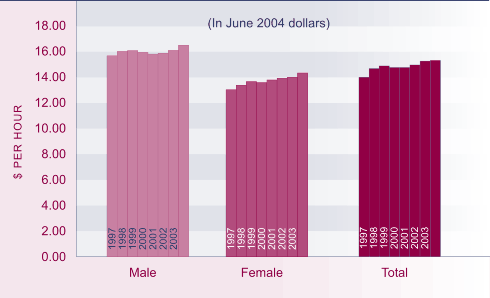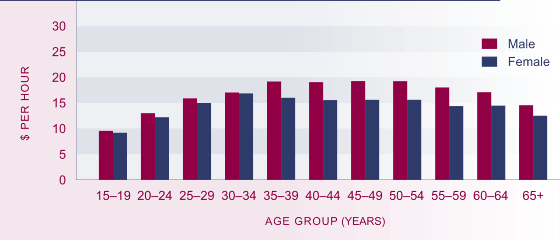Median hourly earnings
Definition
Real median hourly earnings from all wages and salaries for employees
earning income from wage and salary jobs, as measured by the New Zealand Income
Survey.
Relevance
Median hourly earnings from wage and salary
jobs is an indicator of the financial return from paid employment, independent
of the number of hours worked.
Current level and trends
In June 2004, half of all people employed
in wage and salary jobs earned more than $15.34 an hour. The median hourly wage for
male employees was $16.50 while for female employees it was $14.40.
Real median hourly earnings increased by $1.29 per hour or 9 percent
in the seven years to June 2004. The increase over this period was greater
for female employees (10 percent) than for male employees (5 percent). As a
result, the ratio of female to male real median hourly earnings has risen from
83 percent in June 1997 to 87 percent in June 2004.
Figure PW3.1 Median hourly earnings from wage and salary jobs, by sex,
June 1997 to June 2004

Source: Statistics New Zealand, New Zealand Income Survey (1997–2004)
Age and sex differences
In 2004, median hourly earnings from
wage and salary jobs were highest at ages 35–54 years ($17–18 an hour). This compares with
$9.50 for 15–19 year olds. The increase in real median hourly earnings between
1997 and 2004 was smaller for 15–24 year old employees (3 percent) than for
older workers (8 percent for those aged 25–64 years, 11 percent for those aged
65 and over).
In 2004, there was little sex difference in median hourly earnings among
wage and salary earners under 35 years. In all older age groups, the median
hourly wage of employed men was considerably higher than that of employed women.
The sex difference was greatest at ages 45–64 years. However, the ratio of
female to male real median hourly earnings for employees in this age group
improved from 75 percent to 80 percent over the period 1997–2004.
Figure PW3.2 Median hourly wage and salary earnings, by age and sex,
June 2004

Source: Statistics New Zealand, New Zealand Income Survey (2004)
Ethnic differences
In June 2004, half of Māori
in wage and salary jobs earned more than $13.76 an hour, a lower median hourly
wage than that of European/Pākehā ($16.00 an hour) but slightly higher than that of Pacific peoples ($12.98 an
hour). The median hourly earnings of wage and salary earners from the "Other"
ethnic group was $14.68.
Over the seven years to June 2004, increases in inflation-adjusted median
hourly earnings from wage and salary jobs were higher for Māori, at 12 percent, than for Pacific peoples (10 percent) or Europeans/Pākehā (9 percent). Employees from the "Other" ethnic group experienced the lowest
increases in real median hourly earnings from wage and salary jobs (5 percent).
Regional differences
Workers in Wellington and Auckland have
substantially higher earnings than those in other regions. In 2004, the median hourly wage
for wage and salary earners was $17.00 in Wellington and $16.48 in Auckland. Median wages were lowest in Otago ($14.00). Over the period 1998–2004, real
median hourly wages increased most in Northland and Manawatu-Whanganui and actually
declined slightly in Otago and Southland.
|


